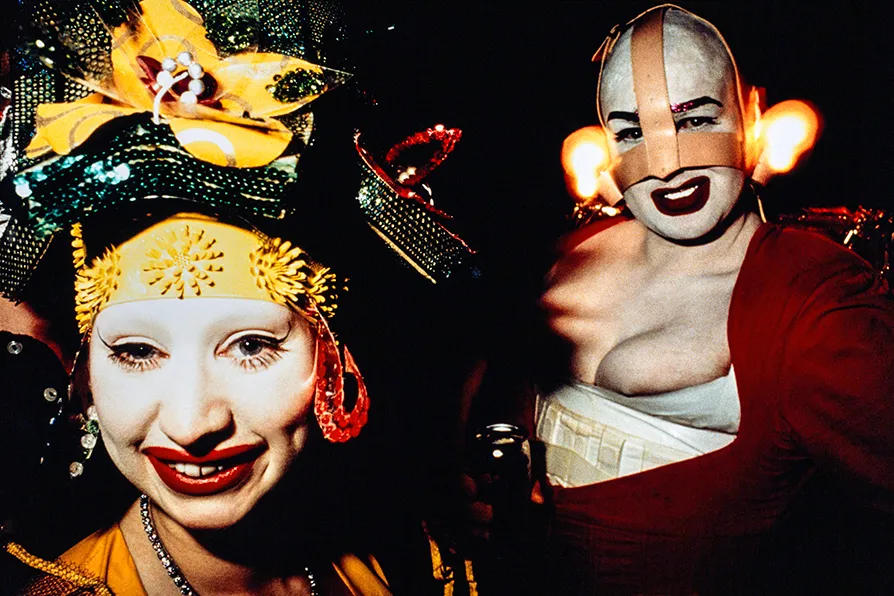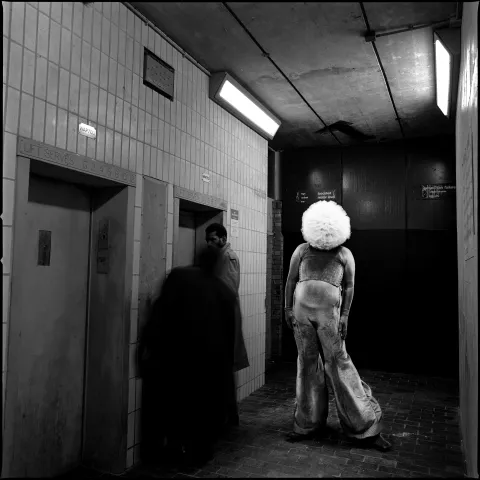MARIA DUARTE picks the best and worst of a crowded year of films
MATTHEW HAWKINS enjoys the perverse jocularity, depraved glamour and inner turbulence of the Tate gallery’s tribute to Leigh Bowery

 Daisy Chain at the Fridge Jan '88: Leigh & Nicola 1988 [Pic: Dave Swindells]
Daisy Chain at the Fridge Jan '88: Leigh & Nicola 1988 [Pic: Dave Swindells]
Leigh Bowery!
Tate Modern, London
★★★★
THE mounting of Leigh Bowery! at London’s Tate Modern enables a view of artifacts dating from the time of his 1980 arrival in London — from Melbourne, sewing machine in hand — up until his catastrophic death in 1994. The current show largely features clothing and its capture in still and moving image.
Awed questions arise as we take on board how it must have felt to shoehorn flesh and blood into the elegantly grotesque constructions on show here, knowing that one would be caged within for the hours demanded, across journeys, service vestibules, and stages — be these ornate or edgy.
Gallery-goers will weigh up notions of the wearer’s acute sensation against his pleasure in fomenting a brew of reaction and response. Amid the volatility and the radical body-politics, we can thank the gay gods for the camp of it all. It may not have been easy to be this hyper-aware restless Australian, but clearly it was fun trying.
The exhibition starts with an evocation of the Bowery abode; the spacious council-flat eyrie that served as his sweatshop and nerve-centre. Cabinets in the exhibition’s first room house numerous early notebooks beside design sketches of surprising detail and scrupulous care. A sheet of portrait-proofs, courtesy of a coin-operated photo booth, demonstrates optimism and a perceptive study of subtleties.

Camera-consciousness thereafter increases exponentially. We witness how Bowery became insatiable for the male gaze.
Further along, an installation features wardrobe items dumped on a kerbside. This references a phase when the artist enjoyed discarding worn pieces off his balcony, documenting their flight and their place of landing. This did not happen in arty Bloomsbury or Camden Town but out east between Aldgate and Limehouse: a deprived grey area where a void left by the collapse of commercial dockland activity was still fringed by small-scale rag trade manufacturing hubs, and pigmented by the culture of a significant south Asian community.
Leigh Bowery’s Stepney-centric sensory binge morphs into a skilled strategy of provocation in this exhibition’s parade of popular media manifestation and its generous video loops.

Whereas our culture readily proffers the labels “maverick” and “eccentric,” this artist seems not to have settled for such roles. Joyously, I think, curators at Tate Modern have shown how cleverly Bowery positioned himself as an insider: fronting a club that everyone wanted to enter, dependably manifesting an affable quick-witted persona beneath his rigorously crafted casings, and skilfully inhabiting stages offered by prominent figures.
When we eventually come to the hefty hang of Lucian Freud nudes, for which Bowery patiently modelled, this could be meant to signal some kind of confirmed status. Andrew Logan, Charles Atlas, John Maybury, Michael Clark and Jeffrey Hinton — artists (albeit gay ones) with wide committed audiences — had already provided a forum for Leigh’s documented performances, as is copiously evident here. There’s also material that reveals Bowery’s ready renown amid massive hedonistic dance-crazy communities on both sides of the pond.
Meanwhile, the Freud masterpieces key into psychological underpinning. Finally, wall-sized video projection displays the throb and thrash of Leigh’s rock-opulent band Minty, its perverse jocularity, the depraved glamour of its surface presentation and the turbulence at its inner core.
One gleans citation of influence among subsequent folk, including today’s heroes of subversive popular entertainment, performance art and protest. Does Extinction Rebellion not borrow something of the same desire to provoke and perform by means of outlandish costume? Alternative manifestation and body modification can be successfully arresting. Did Bowery not reinvigorate a carnivalesque aesthetic that has enriched the political movements that follow him?
Such notions arise at Tate Modern, evidenced by giddying levels of craft and a unique signature.
Runs until August 31. For more information see; tate.org.uk.










